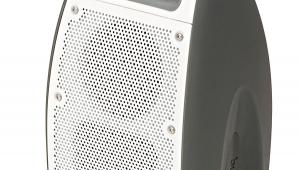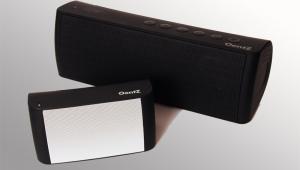I appreciate you sharing this review about jawbone big jambox. Additionally, I would like to introduce you to uno online on the internet. I hope I can be of help to you.
Review: Jawbone Big Jambox

The original Jawbone Jambox Bluetooth speaker has won raves from us and seemingly everyone else who reviews portable audio gear. That’s partly because of the Jambox’s great sound, partly because of its cool industrial design, and partly because of its flashy programmable features. But even the most shameless marketing guy wouldn’t say the Jambox’s 1.25-inch drivers rock.
The new Big Jambox amps up the concept with 2.2-inch drivers; dual 2.2-by-3.8-inch passive radiators instead of the Jambox’s single 1.2-by-2.4-inch radiator; and 18-watt-per-channel digital amps replacing the Jambox’s 4-watters. It’s also much more massive: 10 inches long and 2.7 pounds, compared to 6 inches/0.8 pounds for the Jambox.
Thus, the Big Jambox isn’t merely an improved Jambox. It’s a whole different animal, the kind of product you’d use around the house or take for a week-long vacation at a Cape Cod beach house. The original Jambox is more the kind of thing you’d toss into your laptop bag for a quick biztrip to Boston, or maybe even hang around your neck. The Jambox includes a simple, slim carrying case, while the Big Jambox’s nicely designed, well-padded case costs $49 extra.
Despite the size difference, the units work mostly the same way. They connect to your smartphone through Bluetooth A2DP wireless, and to anything else through a 3.5mm analog stereo input. They have molded + and – volume buttons on top; the Big Jambox adds play/pause and forward/reverse track skip buttons. They both have a built-in microphone so you can use them as speakerphones. And they’re both powered by rechargeable batteries; Jawbone rates the Big Jambox for 15 hours of play time at an average 85 dB volume.
The Big Jambox includes Jawbone’s new LiveAudio technology, which employs crosstalk cancellation as well as some apparent EQ tweaks in an effort to produce a more exciting sound. The original Jambox can also be updated with LiveAudio. Weirdly, Jawbone’s website touts LiveAudio’s ability to reproduce binaural recordings properly without using headphones, but I reckon there are probably more Miles Davis CDs than binaural recordings on the market today. Perhaps Chesky Records’ recent foray into binaural will help.
Jonesin’ to jam
As luck would have it, I received the Big Jambox review sample shortly before I left for a 2.5-week driving trip through the Pacific Northwest. This gave me the chance to try the Big Jambox in a variety of environments: in large hotel rooms, small motel rooms, friend’s houses, and even on the tailgate of my Honda Element, providing a little Sonny Rollins in the background while I was wrenching on my recumbent trike.
Whether I used the Big Jambox with my Motorola Droid Pro cellphone or my iPod touch, the Bluetooth mating process was a cinch. What’s fresh about the Big Jambox is that it can mate with two devices at once, so you and a friend can share your favorite tunes with each other or, more likely, fight over the Big Jambox’s resources. You see, the Big Jambox can’t play two Bluetooth sources at once. If my Droid was playing and I hit play on my iPod touch, the iPod would take over and the Droid would go into pause. If I then hit play on my Droid, the Droid’s music would resume and the iPod would go into pause. If you have two kids, each equipped with a smartphone, I strongly suggest you buy them each their own Big Jambox. You’ll gain peace of mind and probably save on hospital bills.
Although it’s not necessary to do so, I downloaded the Jawbone Updater software onto my PC and used it to customize the Big Jambox through a USB connection. This allowed me to dispense with the voice announcements that occur when the unit is turned on or off, substituting them with cheesy 1980s 8-bit videogame sounds. You can also choose from a variety of other voices, and you can program the Big Jambox so it dials the phone number of your choice at the touch of the talk button. The Jawbone Companion app for Android gave me a few additional options — most notably an onscreen meter that told me how much life was left in the Big Jambox’s battery.
I consider the optional case a must for the Big Jambox. The unit itself isn’t sturdy enough to survive being tossed in a trunk, at least not without scratching or denting its exterior. Wisely, Jawbone designed the case with a compartment for the unit’s power supply.
Bigger sound?
The very first tune I played on the Big Jambox was “Morenita do Brazil,” from the Hanser-McClennan Guitar Duo’s La Vida Breve, which I downloaded in my hotel room after discovering it on a classical program played by Moscow, Idaho’s NPR affiliate. I bought La Vida Breve because I was struck not only by the facility and musicality of the duo, but also by the clarity of the guitars’ sound, which was readily apparent even through my Element’s factory audio system. Even though the Big Jambox’s internal speakers are spaced too closely to permit real stereo imaging, I was floored by how real the duo’s nylon-string guitars sounded. Not only did the guitars sound almost as if they were in the room with me — with far more body and realism that I expected from a portable speaker — but the sound was so detailed I could hear the subtle scrapes of the duo’s obviously well-cared-for nails across the strings.
I got a fuller picture of the Big Jambox’s sound quality when I put on jazz singer Susie Arioli’s gorgeous rendition of “I’ve Got It Bad and That Ain’t Good” (from It’s Wonderful). The tonal balance sounded pleasingly even, with pretty satisfying bass, clear mids and nicely extended treble. I never had the occasional passing thought that I was listening to a good home system, the way I might with the original Jambox and the Soundmatters FoxL v2, but still, I was able to get into the music and forget about reviewing gear for a while.
I did hear a couple of frequency response quirks: a somewhat thin-sounding midrange and a bit of overemphasis in the mid-treble region. Voices made the treble zing apparent, lending a bit of extra sibilance. I also got pretty weird sound on the acoustic guitar intro of Led Zeppelin’s “Over the Hills and Far Away”; the treble sounded uneven, like someone had played around with an equalizer between 3 and 10 kHz. But when the entire band kicked in, the effect mostly disappeared, replaced by a nice, satisfying rock groove.
While the original Jambox played just loud enough to fill a typical hotel room, the Big Jambox plays loud enough to get you thrown out of a hotel room. Even the chatter from NPR’s “Morning Edition,” played loud enough so I could hear it while showering, was enough to get the guy in the next room at Kellogg, Idaho’s GuestHouse Inn knocking on my door. The good news here is not so much that can you drown out crying babies and barking dogs in the next hotel room, but that the Big Jambox has loads of headroom. Unlike the original Jambox or the FoxL, you don’t have to push the Big Jambox to the edge of distortion to get it to fill your room with sound.
Unfortunately, I can’t be as enthusiastic about LiveAudio. While it does produce a more spacious sound, the effect sounded phasey, disembodied, and overdone. I heard a tiny, feeble center image coming from the Big Jambox with various bits of sound swirling around the room. What’s worse, it seemed to create resonant peaks in the bass and treble. Singers sounded unnaturally and annoyingly bloated, and their voices also took on a sizzly edge because of the apparent high-frequency boost. I tried LiveAudio with various music tracks and other programs, but couldn’t stand the subjective effect it had on the Big Jambox’s tonal balance.
To be fair, LiveAudio did sound pretty good on “Man Walking From A to B,” from Tony Levin, Jerry Marotta, and Steve Gorn’s binaural recording From the Caves of the Iron Mountain, giving me a nice sense of spaciousness with no apparent ill effects on the tonal balance. I can’t say whether in this case LiveAudio worked well because the recording is binaural or because it’s such a sparsely arranged tune (just Chapman Stick, wood flute, and Taos drums). But I can say that Caves is the only binaural recording I’ve acquired in 30+ years as a music fan. So if LiveAudio is in fact optimized for binaural recordings, its applications are limited to say the least.
As a speakerphone, the Big Jambox worked beautifully. I used it for several business and personal calls during my trip, in most cases asking the person on the other end of the line how my voice sounded to them. The response was always “good” or “very clear.”
- Log in or register to post comments


Appreciate the thorough analysis. Understanding the bass output and dispersion characteristics is crucial for choosing the right speaker. Your girlfriend perspective adds a refreshing simplicity to the review.
Tax Accounting Services in Louisville

It’s a whole different animal, the kind of product you’d use around the house or take for a week-long vacation at a Cape Cod beach house.





























































